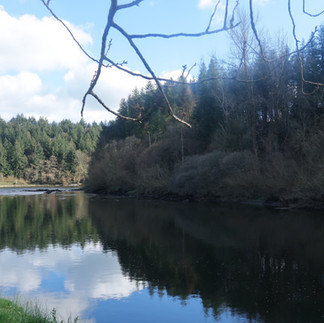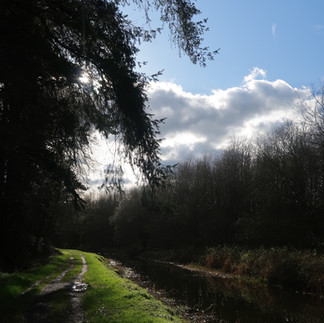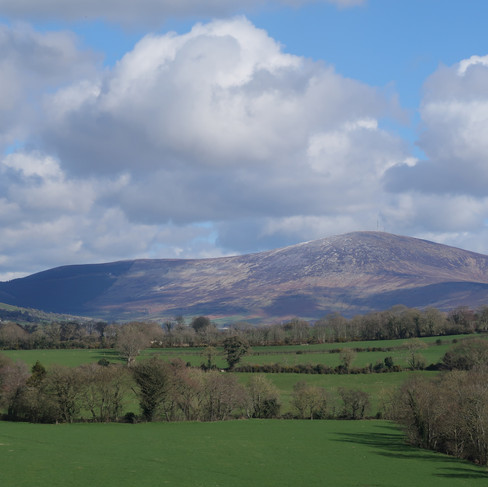
Ireland's second smallest county certainly packs a powerful punch. Though compact geographically, Carlow is chock-full of scenic gardens, historic architecture, forest parks and river walks, not to mention VISUAL, its cutting-edge contemporary art centre. It's also home to some of Ireland's prettiest towns and villages, as my two recent trips revealed. I'm ashamed to say that this was my first proper exploration of the county but it won't be my last.

Is Carlow worth visiting?
Absolutely. Bordered by the dramatic peaks of the Blackstairs to the south-east and Brandon Hill to the west, the landscape is undulating and wildly beautiful. A scattering of overnight snow in March completed the postcard-perfect vista, prompting many spontaneous roadside stops to capture the scene on camera, while on a second visit in May, the landscape was transformed by acres of bright yellow fields of rapeseed.

Things to do in Carlow:
Start your tour with a visit to the wonderful Delta Sensory Gardens outside of Carlow town. Tucked away at the end of an industrial estate, its unassuming location belies a garden of delights for both adults and children alike. As suggested by the name, the gardens are a feast for the senses, where everything is designed to be touched and smelled; where the air is punctuated by the gentle sounds of rippling water, and with something quirky and new to be discovered around every corner. Think life-sized board games, waterfalls and a sculpture garden, to name but a few.

The gardens are part of the nearby Delta Centre for adults with intellectual disabilities, and officially opened to the public in 2007 as the first of its kind in Ireland. The initial concept was for the creation of a therapeutic outlet for its service users offering a completely immersive and sensory experience. The entrance fee is an important source of funding to help support their services and ongoing work.
A series of distinct but interconnected gardens stand on either side of Celtic Walk, an impressive central avenue lined with colourful, seasonal blooms and yew hedges. The wonderful Thistle Fountain is your introduction to the site: children will jump with joy as water spurts dramatically from its many nozzles. Close your eyes and listen to the hypnotic sound of the water as it hits the stones below, and feel its gentle spray on your face. It's a masterful piece of visual trickery - in full flow, it creates the illusion of a perfect thistle.
One of the most gloriously tactile pieces is the Kugal - a pink marble sphere floating on a cushion of water in the Five Senses Garden. It's impossible to resist running your hands over its smooth flawless surface. And unlike some other stuffy outdoor sculpture gardens, here you are actively encouraged to engage with the work and get up close and personal. It's a very satisfying sensation.

Don't miss the Stolen Child Garden which takes its name from a poem by W.B. Yeats. A circle of native Irish trees create a wild, natural cocoon and it may take some time for your eyes to adjust to its man-made features. Like a Magic Eye picture, the reclined figure of a female eventually reveals itself beneath a grassy mound.
You'll find your sense of smell heighten as you make your way through the winding garden paths, breathing in the coconutty smell of the vivid yellow gorse and the heady herbal scents of sage, rosemary and lavender. Water-features in varying formats are dotted throughout the grounds, the gentle lapping melody providing a soothing soundtrack to your visit.
Unmissable is the Iris O'Brien Health and Wellness Garden, an oasis of tranquility at the end of the Celtic Walk. A canal runs through the heart of it beneath a series of contemporary arches, while a cleverly-placed mirror at one end gives the illusion of length. Overhanging plants in vibrant pops of colour complete the picture, creating a serene, harmonious space.

Another interesting tidbit of information from the audio-guide... Run your hands along the smooth, sage-green arches for some more visual trickery. No, they are not made from concrete but large blocks of polystyrene. Feeding into the overall clever design concept, this material absorbs heat, raising the temperature within the garden, generating its own micro-climate. Seriously cool.
Next up is the Sculpture Garden, perfectly framed through a series of organic arches. The smooth tactile surfaces of the limestone pieces are crying out to be touched. In fact, it's actively encouraged here so take advantage of the opportunity. Two large organic shapes stand at the heart of the garden, thought to represent the opposing but interconnected forces of Yin and Yang.
Peas drop from an open pod which appears to droop forward while conkers lay cracked open on the ground, as if they'd fallen from the trees above. Bob Frazier's crow perches on a branch above our heads, overseeing its territory.

And now for the Games Garden, sure to be a hit with kids, and big kids alike. Here you'll find a giant game of chess, a granite table with a beautifully-carved game of Snakes & Ladders and another set up for a game of draughts. Everything is designed to be played with. It's so fun.
Make sure to pick up a map at reception, and to download the free audio guide to accompany your walk. The full audio tour takes about 45 minutes but give yourself at least an hour to fully immerse yourself in the space; to sit quietly and take in the sights, sounds and smells that surround you - a truly mindful experience.
Café Thyme is the popular on-site café, serving up excellent coffee and cakes, as well as a wide-ranging breakfast and lunch menu focused on fresh, locally sourced produce. I arrived too late for lunch but can highly recommend their Rice-Crispy cake bars.
Entry: €6 for adults. €5 for students and senior citizens. Children under 13 go free.
One of the most iconic and most photographed features on the Carlow landscape is Duckett's Grove, an imposing Gothic pile of towers and turrets silhouetted against a backdrop of the Blackstairs Mountains. Visit from April to late summer when the surrounding landscape is transformed by fields of joyous yellow rapeseed - it's quite a spectacular sight.

Though now in a ruinous condition (it was destroyed by a fire in 1933), the mansion is still an impressive spectacle. Home to the Duckett family from the 18th - 20th centuries, it was once the centre of a vast 12,000 acre estate. We get some sense of its former glory from The Towers, one of its dramatic gate lodges at the southern end of the grounds and one of the key access points to the site today.
This structure is considered to be of significant architectural importance, and among the most elaborate castellated gate lodges in Ireland. Look out for the impressive Duckett family coat of arms above the pointed arch.

A gate lodge at the other entrance to the estate perfectly frames views of the vibrant fields of gold beyond.
While the interior ruins of the house are off-limits to visitors for health and safety reasons, many of the external features are in still intact including the picturesque octagonal viewing tower and a series of gargoyles peering down on you from above.
You cannot fail to be wowed by the view on first approach, particularly in the early months of summer with rows of pretty pink cherry blossom trees lining the avenue.

Today it is worth visiting for its two beautiful interconnecting walled gardens. Duckett's Grove was acquired by Carlow County Council in 2005 who undertook an extensive restoration to bring the gardens back to their original glory. The upper walled garden showcases a mixture of shrubs and brightly-coloured flowers with benches dotted around its perimeter to sit and enjoy the view.
The two gardens are linked by a gateway in the attractive exposed brick wall, framing some postcard-perfect views in both directions. Early summer is a fabulous time to visit when nature is blooming and springing to life all around you, and the soothing sounds of birdsong fill the air.
Native Irish apple trees line the walkway in the lower walled garden. You'll also find a wide variety of fruit including figs, mulberries, damsons, pears and plums.
Both gardens are beautifully framed with manicured boxwood hedges. Beyond the walled gardens you'll find a playground. There is also a large car park and a café (though café was not open at the time of my visit in early May 2023).
Free admission. For opening hours and directions, click here
Top of any visitor's list should be a visit to Altamont Gardens, a haven of tranquility just a short distance from Tullow.

Spread over 40 glorious acres you'll find a mix of formal and informal gardens, lake and river walks, and an extensive collection of plants, trees and flowers. The grounds are a haven for wildlife while ducks wander confidently throughout the grounds, asserting authority over their demesne.
I was reliably informed that the gardens get quite busy at weekends, particularly so for this year's snowdrop season in February. It seems the secret is out, no doubt down to the efforts of Carlow Tourism who have really hit the ground running recently with a wide-reaching promotional strategy across their social media platforms. However, on a bitterly cold blue-sky Tuesday, I pretty much had the place to myself (apart from the ducks, of course...)

The elegant house dates to the mid-18th century, on the site of an earlier dwelling. Though it's not accessible to the public, it's worth taking a wander to admire the beautiful fanlight above the door, and its satisfying symmetrical detailing.

From the rear of the house, make your way towards the ornamental lake, home to a family of moorhens and ducks. The beautifully manicured lawns are punctuated by a number of walkways: highlights of the central Broad Walk include 150 year old box hedges, fine specimens of Irish Yew and an incredible 100 varieties of snowdrop. To the left is the ominously named Dark Walk: the site map recommends a visit in early summer to view the exotically vibrant red rhododendron 'Doncaster'.

The lake stands at the the heart of the estate, towered over by the imposing Swamp Cypress tree which casts wonderful reflections on the water. The lakeside scene is an idyllic one, surrounded by trees, tentative buds and blooms in a rich palette of spring colours. Moorhens float nonchalantly past while a cacophony of birdsong fills the air. Seats dotted around the edge of the lake encourage visitors to sit and enjoy the view.

Follow the walkway to the left through the arboretum, past the Bog Garden and the dramatic Ice-Age glen. Its paths are crisscrossed by a series of gurgling brooks and streams, adding a hypnotic soundtrack to the forest setting. It's incredibly peaceful.
As the path curves to the right, a gap in the trees reveals expansive views in both directions of the River Slaney. Standing on the river bank surrounded by woodland, I was struck by the sense of absolute stillness and silence. Benches are strategically-placed for visitors to drink in those views, and for some mindful moments of contemplation.

Test your fitness levels at the One Hundred Steps - a series of hand-cut granite steps initially laid to navigate the steep gradient back up from the river bank. Traversing Bluebell Wood, this must be an impressive sight from late March to early May when the flowers are in full bloom.
A gentle incline across the lush green Sunset Field reveals the Temple of the Four Winds. But appearances can be deceptive - despite its nod to Classical tradition, it turns out it was actually only built in the late 1990s. From up here visitors can enjoy breathtaking panoramic views of the Blackstairs and Wicklow mountains.
On your way back to the entrance, cross the stone bridge and walk beneath the pergola which is lined with vibrant rows of daffodils - a cheery sight.
Before you leave, make sure to stop off at the lovely Altamont Garden café, serving up good coffee and some tasty home-baked treats. I'd highly recommend the cherry bakewell. For colder days, take advantage of the covered-over seating area which comes equipped with cosy blankets. Or if you're feeling brave, wrap up and sit in the delightful garden terrace, its pathways lined with colourful blooms while a friendly fat robin hops from table to table, scavenging for crumbs. The manager informed me that he literally rules the roost and doesn't let other birds infringe on his territory. He gets away with it as he's super-cute.
Free entry but there is a €2 fee for all-day car parking.
Open all year round - opening times here
Next stop - the ridiculously picturesque village of St Mullins in south Carlow, as recommended by the friendly lady in the Altamont café. Set into a wooded valley and benefitting from a spectacular riverside location between the Blackstairs Mountains and Brandon Hill, St Mullins Village is best-known for its 7th century monastic settlement: visible today are the remains of a round tower and five churches.

But my main reason for visiting was food-related... A series of positive reviews led me to the Mullichain Café, sited literally on the banks of the River Barrow. Though they also have indoor seating, wear an extra layer or two and take up one of the outdoor benches instead for sweeping views in both directions along the River Barrow, surrounded by woodland.
The welcome was warm and friendly, and the offer of a blanket for sitting outside was much appreciated. Coffee was good and strong, and the ham, pesto and cheese panino was a cut above the usual. Pricier than average too but totally worth it for the setting.
Walking enthusiasts are totally spoiled for choice in Carlow. For those with stamina, there are lengthy, cross-county walks including the beautiful Barrow Way (113km - from Robertstown, Co. Kildare to St. Mullins, Co. Carlow) and the newly launched Columban Way - a 45km heritage trail following the footsteps of St Columbanus through counties Carlow and Wexford. This is the first stage of the route - upon completion it will continue through eight counties, tracing a 530km route to Bangor, Co Down.

But for those who aren't willing to commit to a full day's hiking, there is are plenty of short & sweet looped walks to enjoy at a leisurely pace. I detoured to the Clashganny Forest Trails - approximately half way between St Mullins and Borris.

Here you have two choices: the Clashganny Lock Loop (4kms - follow the green arrows) or the Clashganny Forest Looped Walk (6kms - purple arrows). I opted for the latter - a gentle riverside stroll with a relatively steep incline through forest at the end. Yellow arrows signify the section which forms part of the Barrow Way.
Both routes start and end at the Clashganny Lock car park. Turn left onto the lateral canal which runs parallel to the river, and follow its path downstream until you reach Ballykeenan Lock, the only double lock out of 23 on its route.
Here, the canal merges with the River Barrow, opening out to some truly magnificent views in all directions.

Soon after this point, follow the purple arrow, taking a sharp left back uphill through the forest. A slow but steady incline for approximately one kilometre runs through a richly wooded area with occasional glimpses of the river below. Follow the forest track uphill to the Clashganny Viewing Point car park and you are in for a treat. A vast panorama unfolds, framed by trees, with views of the canal and river as they snake their way through the lush green landscape. The mountains complete the picture, providing an impressive backdrop.

From here, the route continues downhill along a tarmac road - for safety, walk on the narrow path to the left as it is protected by railings. Near the bottom, keep your eyes peeled for a stile to rejoin a path through the woods, descending by an atmospheric old mass rock on elevated ground, almost obscured from view by trees. Mass rocks were altars used for clandestine Catholic masses during Penal Times and for this reason, tend to be found in isolated or hidden places.
Turn left on the road to return the short distance to the car park.
Don't miss one of the county's architectural gems - the remarkable Borris Viaduct.

This immense sixteen-arch structure is 60ft high and is considered one of the best examples of 19th century engineering in Ireland. It's a jaw-dropping site on approach by road, the archways revealing the peaks of the Blackstairs Mountains as a dramatic backdrop.
Visitors can experience its vast scale for themselves by strolling the Borris Viaduct Walk which runs for 1km along the top. Railings have been installed across the top for safety, and there are car parks at both ends. The old one is at the corner of the R702 main road from Borris (follow the signs for Viaduct Walk) while the new car park is beside the school. From here, a winding ramp brings you to the top of the Viaduct - ideal for buggies or wheelchairs. History buffs will delight in the number of interesting historical information points dotted along the way. There is also a picturesque woodland walk below the bridge, with picnic tables for a pitstop lunch.
And that concludes my whistle-stop tour of Carlow. Looking forward to a return trip
Happy day-tripping
K xx
































































































Comments